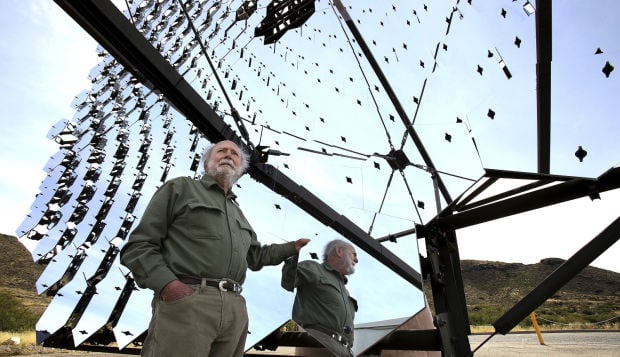Trevor Weekes, who pioneered the science of gamma-ray astronomy and led development of the VERITAS array on the slopes of Mount Hopkins, died Monday at age 74.
“Trevor was a visionary scientist who opened a new window on the universe,” wrote Charles Alcock, director of the Harvard-Smithsonian Center for Astrophysics in an announcement of Weekes’ death.
James Cornell, a longtime friend and colleague at the Harvard-Smithsonian Center, said Weekes “kept this arcane field of astronomy going through a long, dark period.” Others had given up on receiving signals from the most energetic outbursts in the cosmos.
For a December story in the Arizona Daily Star, Weekes described the target of his branch of astronomy.
“The types of things we look for are pathological — stars that have exploded, the centers of galaxies where massive black holes are accreting matter. We are looking at energies and conditions that cannot be duplicated on Earth.”
Astronomers could not directly detect the extremely high-energy particles, which disperse in an ephemeral flash of blue light called Cherenkov radiation when they hit Earth’s atmosphere.
Recording those flashes required bigger detectors and more computing power than were available when Weekes and a handful of other physicists and astronomers began looking for signals in 1966 in the Santa Rita Mountains, using mirrors scavenged from searchlights.
Eventually, with larger detectors, Weekes and colleagues recorded the first signal, from the Crab Nebula, in 1989.
Today, the four 12-meter detectors of VERITAS — Very Energetic Radiation Imaging Telescope Array System — flank the visitors’ center of the Smithsonian’s Fred Lawrence Whipple Observatory on the road to Mount Hopkins.
Discoveries made there and at a handful of other places have led an international consortium of scientists to plan massive arrays of Cherenkov detectors, seeking answers to essential questions in astronomy, cosmology and particle physics. “The field is hot,” said Cornell, president of the International Science Writers Association.
In addition to his gamma-ray work, Weekes ran the observatory as science director during some troubled times and worked tirelessly to bring his science to the public, said Cornell.
He also mentored graduate students, including 30 from his alma mater, University College in Dublin.
“Every postdoc, student or visitor was always welcomed into our home,” said his daughter Karina Bolger. “I can’t recall a single Christmas when it was just my family.
“Many are coming back on Sunday to honor him, flying from Ireland and Montreal. He wasn’t just their adviser. He became their mentor and friend and parental figure.”
Weekes received his Ph.D from University College Dublin. He has honorary degrees from the National University of Ireland and the University of Chicago.
He received the Rossi Prize from the American Astronomical Society in 1997 and the Yodh Prize from the International Union of Pure and Applied Physics in 2007.
He has lived in Sahuarita since 1970.
He is survived by his wife, Ann Owens Weekes; sister, Laraine Joyce, of Dublin; daughters Karina Bolger of Austin, Texas, Fiona Hill, of tlanta and Lara Scherck of Sausalito, Calif.; and four grandchildren.
Memorial services are 3:30 p.m. Sunday at Most Holy Trinity Church, 1300 N. Greasewood Road in Tucson.
The family requests donations to Casa Maria, 401 E. 26th St., Tucson, AZ 85713.






